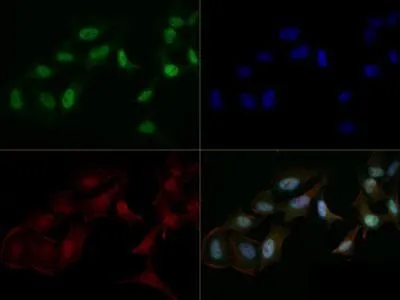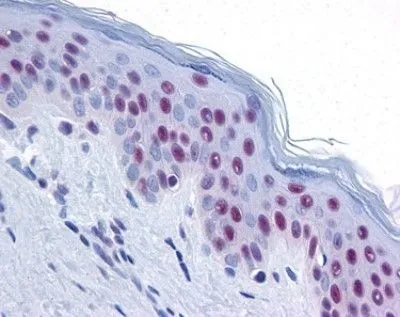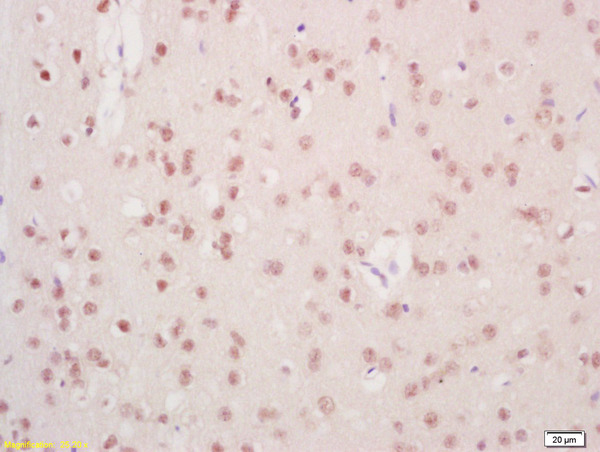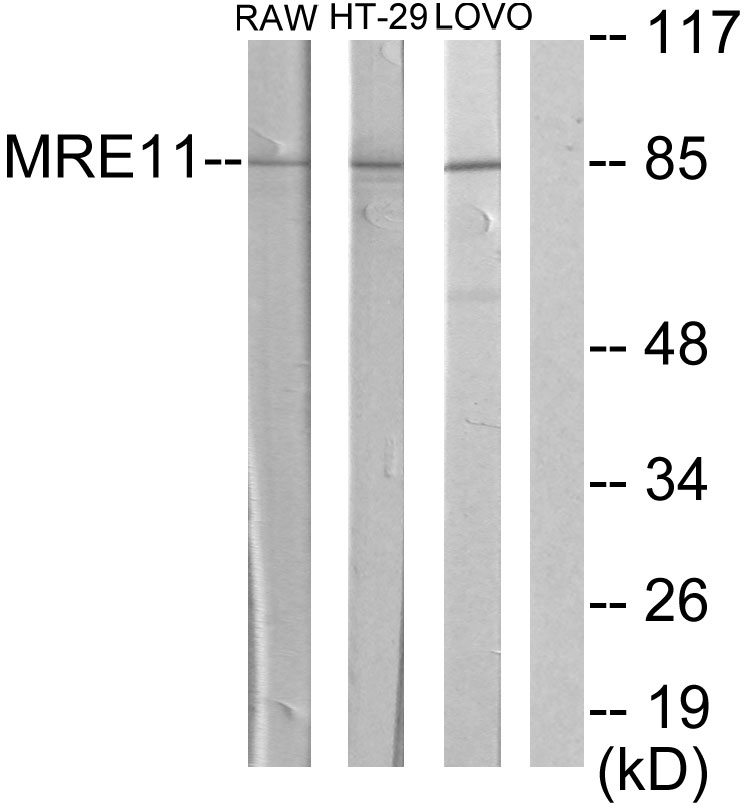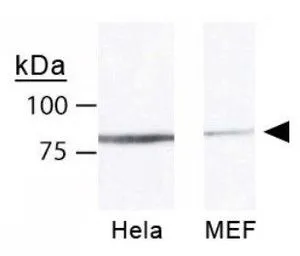
WB analysis of HeLa and MEF cell lysate using GTX30294 Mre11 antibody.
Mre11 antibody
GTX30294
ApplicationsFlow Cytometry, ImmunoFluorescence, ImmunoPrecipitation, Western Blot, ChIP Chromatin ImmunoPrecipitation, ImmunoCytoChemistry, ImmunoHistoChemistry, ImmunoHistoChemistry Frozen, ImmunoHistoChemistry Paraffin
Product group Antibodies
ReactivityChicken, Hamster, Human, Mouse, Rat
TargetMRE11
Overview
- SupplierGeneTex
- Product NameMre11 antibody
- Delivery Days Customer9
- Application Supplier NoteWB: 1:5000. ICC/IF: 1:200. IHC-P: 1:10 - 1:500. IP: 3 ul. *Optimal dilutions/concentrations should be determined by the researcher.Not tested in other applications.
- ApplicationsFlow Cytometry, ImmunoFluorescence, ImmunoPrecipitation, Western Blot, ChIP Chromatin ImmunoPrecipitation, ImmunoCytoChemistry, ImmunoHistoChemistry, ImmunoHistoChemistry Frozen, ImmunoHistoChemistry Paraffin
- CertificationResearch Use Only
- ClonalityPolyclonal
- ConjugateUnconjugated
- Gene ID4361
- Target nameMRE11
- Target descriptionMRE11 double strand break repair nuclease
- Target synonymsATLD, HNGS1, MRE11A, MRE11B, double-strand break repair protein MRE11, AT-like disease, DNA recombination and repair protein, MRE11 double strand break repair nuclease A, MRE11 homolog 1, MRE11 homolog A, double strand break repair nuclease, MRE11 homolog, double strand break repair nuclease A, MRE11 meiotic recombination 11 homolog A, MRE11 meiotic recombination 11-like protein A, double-strand break repair protein MRE11A, endo/exonuclease Mre11, meiotic recombination 11 homolog 1, meiotic recombination 11 homolog A
- HostRabbit
- IsotypeIgG
- Protein IDP49959
- Protein NameDouble-strand break repair protein MRE11
- Scientific DescriptionThis gene encodes a nuclear protein involved in homologous recombination, telomere length maintenance, and DNA double-strand break repair. By itself, the protein has 3 to 5 exonuclease activity and endonuclease activity. The protein forms a complex with the RAD50 homolog; this complex is required for nonhomologous joining of DNA ends and possesses increased single-stranded DNA endonuclease and 3 to 5 exonuclease activities. In conjunction with a DNA ligase, this protein promotes the joining of noncomplementary ends in vitro using short homologies near the ends of the DNA fragments. This gene has a pseudogene on chromosome 3. Alternative splicing of this gene results in two transcript variants encoding different isoforms. [provided by RefSeq]
- ReactivityChicken, Hamster, Human, Mouse, Rat
- Storage Instruction-20°C or -80°C,2°C to 8°C
- UNSPSC12352203
References
- Kim H, Kim D, Choi H, et al. Deubiquitinase USP2 stabilizes the MRE11-RAD50-NBS1 complex at DNA double-strand break sites by counteracting the ubiquitination of NBS1. J Biol Chem. 2023,299(1):102752. doi: 10.1016/j.jbc.2022.102752Read this paper
- Kim H, Choi H, Im JS, et al. Stable maintenance of the Mre11-Rad50-Nbs1 complex is sufficient to restore the DNA double-strand break response in cells lacking RecQL4 helicase activity. J Biol Chem. 2021,297(4):101148. doi: 10.1016/j.jbc.2021.101148Read this paper
- Siwicki JK, Degerman S, Chrzanowska KH, et al. Telomere maintenance and cell cycle regulation in spontaneously immortalized T-cell lines from Nijmegen breakage syndrome patients. Exp Cell Res. 2003,287(1):178-89.Read this paper
- Cleaver JE, Bartholomew J, Char D, et al. Polymerase eta and p53 jointly regulate cell survival, apoptosis and Mre11 recombination during S phase checkpoint arrest after UV irradiation. DNA Repair (Amst). 2002,1(1):41-57.Read this paper
- Her C, Vo AT, Wu X. Evidence for a direct association of hMRE11 with the human mismatch repair protein hMLH1. DNA Repair (Amst). 2002,1(9):719-29.Read this paper
- Limoli CL, Laposa R, Cleaver JE. DNA replication arrest in XP variant cells after UV exposure is diverted into an Mre11-dependent recombination pathway by the kinase inhibitor wortmannin. Mutat Res. 2002,510(1-2):121-9.Read this paper
- Franchitto A, Pichierri P. Bloom's syndrome protein is required for correct relocalization of RAD50/MRE11/NBS1 complex after replication fork arrest. J Cell Biol. 2002,157(1):19-30.Read this paper
- Wang Y, Cortez D, Yazdi P, et al. BASC, a super complex of BRCA1-associated proteins involved in the recognition and repair of aberrant DNA structures. Genes Dev. 2000,14(8):927-39.Read this paper


